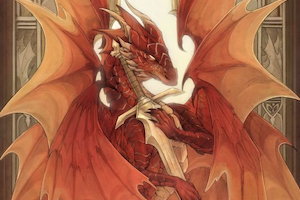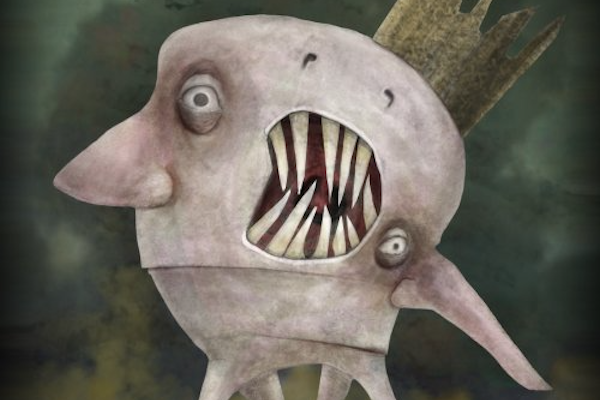Welcome back to Reading the Weird, in which we get girl cooties all over weird fiction, cosmic horror, and Lovecraftiana—from its historical roots through its most recent branches.
This week, we cover E.F. Benson’s “Between the Lights,” first published in The Room in the Tower and Other Stories in 1912. Spoilers ahead!
“No, I don’t mind that sort of thing,” he said. “The paraphernalia of ghosts has become somehow rather hackneyed, and when I hear of screams and skeletons I feel I am on familiar ground, and can at least hide my head under the bed-clothes.”
A half-dozen guests have gathered for Christmas at the country residence of Everard and Amy Chandler, where our narrator has often spent the holidays. All Christmas Eve day, heavy snow falls, but indoors everyone enjoys billiards and Badminton and a romping game of hide-and-seek. As dim white fades into twilight dark, the party gathers for tea and ghost stories illuminated solely by a blazing fire. The guests regale each other with “blood, bones, skeletons, armour and shrieks,” while Everard listens in silence, still looking worn from his illness of that autumn. Narrator has just settled back, certain he’s told the most harrowing tale, when Everard speaks up. Ghosts and skeletons don’t bother him. After all, there are eight skeletons in the room now, disguised beneath skin and flesh. No, it’s the vague nightmares of childhood that were truly terrifying, the ones in which one didn’t know what one feared. If that atmosphere could be recaptured –
Amy rises, saying that Everard can’t want to recapture such terror again. Wasn’t once enough? It was, Everard agrees. But the guests, scenting a true ghost-story, beg him to continue. Narrator feels that the “childish gaiety” of the preceding hours has changed to the tension in which “real terrors were going to lurk in dark corners.”
The extinction of a log throws Everard’s face into shadow, out of which his voice sounds “slow but very distinct.” Last Christmas Eve, he reminds the gathering, the weather was so warm that they played croquet on the lawn, where a single dahlia was still in scarlet flower. He was watching the match when suddenly he shivered. The brick wall surrounding the lawn seemed to heighten and shrink inward until all light vanished save for a glimmer. He fixed on the red dahlia, only to see it become a feeble fire by the light of which he found himself in a low-roofed shed as foul-smelling as “a human menagerie… uncleaned and unsweetened by the winds of heaven.” The inhabitants were human-shaped yet somehow bestial and very small. They chattered and pointed at him. One rose, clad in a knee-length shirt, with bare and hairy arms. Realizing that “nightmare impotence” had paralyzed him, Everard tried futilely to scream. Then, at once, he returned to the croquet lawn, trembling and dripping sweat. He must have fallen asleep and dreamed, yes, yet he’s convinced he did not. Call it hallucination instead.
Dream or hallucination, the vision haunted him for months, as if “something had actually entered into [his] very soul, as if some seed of horror had been planted there.” Morning after morning he’d wake to find himself “plunged into an abyss of despair.” His wife and doctor assured him he wasn’t going mad, and the doctor recommended a change of scene.
They went to London, where the memory of his vision “grew every day more vivid, and ate… like some corrosive acid into [his] mind.” From there, they traveled to a remote and wild part of Scotland. It was close enough to the sea for mists to frequently roll in; the local gillies [guides] warned him to always carry a compass in order to find his way home through the murk. However, a series of clear days made him forget the device.
One day he and his gillie Sandy followed their quarry to a tableland that on one side sloped sharply to a loch, on the other more gently to the river by which his lodge stood. Sandy insisted they climb the more dangerous slope, claiming the deer would scent them otherwise. The going was treacherous, over boulders and among clumps of heather swarming with adders. At the top they found the deer had caught their scent anyway, as anyone should have known from the direction of the wind. Everard wondered what Sandy’s real reason was for avoiding the gentler slope. They were lucky enough by midafternoon to bag a big stag, and Everard felt his dogging dread give way to “an extreme sense of peace.”
Sandy urged their return—a sea-mist was rising and would make the climb down the craggy slope even more difficult. Everard discovered he’d forgotten his compass, more reason to descend by the gentler slope. After much argument, Everard won out. Halfway down, the mist overtook them, but Everard’s respite from fear continued. He lead, Sandy following closely as if scared. Evening approached, the air grew colder, snow began to fall. After confused wandering, Everard heard the river, their goal. Then, as if “in terror of pursuit,” Sandy yelled and bolted out of sight. Everard’s momentary alarm, however, gave way almost to gaiety. He spotted a blackness in the white chaos of the storm. It was a wall with a rough door in it.
He followed a low passage into a circular enclosure open to the sky. Its walls were only four feet high, with broken stones suggesting they once supported a floor. Abruptly his long terror returned, for he saw that his vision was fulfilled and that a figure three and a half feet high was stealing towards him. He heard it stumble over a stone, smelled the overpowering stench of the place, but he couldn’t scream or move. As the figure crept closer, terror broke his paralysis, and he fled the ruin and plummeted down the slope to the river track and his lodge. Next day he started developing the pneumonia that would lay him up for weeks.
Well, Everard says from his armchair, that’s his story. One explanation is that he stumbled into an ancient Picts’ castle where a sheep or goat had taken shelter. But the coincidence between vision and event could give believers in second sight something to mull over.
Is that all, narrator asks. “Yes,” Everard answers. “It was nearly too much for me.” Then the dressing-bell rings and breaks up their tale-telling circle.
What’s Cyclopean: “A temerarious dahlia” still blooms at Christmastime.
Libronomicon: Chandler jokes that telling this story makes him feel like Hamlet directing his play-within-a-play. But who’s the guilty uncle?
Madness Takes Its Toll: Chandler wonders about the sanity of that temerarious dahlia. And also of himself. His doctor says he’s fine, but has no opinion about the dahlia.
Ruthanna’s Commentary
Ah, a cozy old-fashioned Christmas. Roasting chestnuts, ice skates, trees decked with garlands, treat-filled stockings… ghost stories?
Well, yes. How better to pass the time around a crackling fire, than to tell chilling tales that make the firelight feel safer, the gathered friends more necessary for comfort, the spiked punch more appealing? Really, this is a tradition worth bringing back: sharper and stronger than the myriad holiday-themed albums from everyone hoping to find a spot in the modern stocking.
Translated into prose, the teller of Christmas shivers tries to recreate as much of the original cozy context as possible. But Benson’s playing with the form again, and in the opposite direction from chilling-to-cozy “How Fear Departed from the Long Gallery.” His warmly hospitable host, normally a source of croquet and hide-and-seek and otherwise genial house party fare, has a tale he’s reluctant to tell. Apparently, his last house party wasn’t so cozy as all that—even if no one else noticed.
One of the most comforting things about the traditional ghost story is the promise of resolution. The haunt will be explained, or at least captured. Events will flow in somewhat predictable fashion, from initial intimation to hair-raising confrontation. True experiences of the uncanny have no such reassurance. It may simply be a moment of inexplicability, a single event that defies explanation. It probably lacks a clear story arc. It is certainly unlikely to get tied up by a satisfying resolution. So it sticks with you, building chronic disquiet rather than acute adventure.
So too with Chandler’s experience. There’s his initial vision of an ancient setting. (A wretched hive of scum and villainy?) There are the scaled-down humanoid creatures, definitely not hobbits but not anything else specific. Fair folk? Neanderthals? Ghosts? Gnoles? And then he just… can’t get over the vision for months. He’s healthy, but it eats at him. Eventually he goes on holiday to Scotland, like you do. There, despite the best efforts of his hunting guide, he stumbles through the mist and into his vision. And he was having such a nice day, too.
Whereupon he escapes, and never learns anything more about what happened. This despite the fact that gillie Sandy clearly knows something. Maybe Chandler fires the guy for not explaining his anxiety in the first place, or for running away. Maybe Sandy continues to resist saying anything useful despite subsequent demands. Maybe when he ran away, he tripped and fell into a bog. Never mind, leaving it all unresolved makes the whole thing less narratively satisfying, but more plausible. Which, of course, makes it more satisfyingly chill-inducing.
Meanwhile in another story, the mysterious wee beasties are equally confused about this human dude who keeps stumbling into their house.
My favorite part is actually the framing story: the tension between comforting ritual and real fear, between silly and serious play. The house party is a liminal space, where British nobility can drop their dignified armor and play hide and seek, or admit that beneath our outer differences we’re all skeletons—and as we all know, once you release the rigid trappings of imperial culture, anything might happen. Even the admission that said nobles can truly be frightened, and might never understand what they’re frightened of.
Final thing that’s eating at me unresolved: what are the “lights” that the story takes place “between”? The best I can come up with is “lights” as a term for eyes: that the events (or simply the fear of them) takes place between Chandler’s eyes, i.e., in his brain. Dissatisfied with this answer, I tried to figure out if it was a Hamlet reference—no luck, Hamlet talks about light but not anything between lights. Maybe the lights are the explicable, comfortable life on either side of the weirdness. Maybe it’s Chandler’s own fireplace and the beasties’ low, guttering hearth. Or maybe Benson has as much trouble coming up with titles as I do.
Anne’s Commentary
I wondered why Benson titled this story “Between the Lights” rather than something more obvious like “A Christmas Eve Premonition” or “The Exceedingly Malodorous Pictish Ruin in the Mist.” From the title alone, I pictured streetlamps illuminating all-too-short stretches of pavement on a moonless night—between them would be all-too-long stretches of darkness in which anything might be lying in fiendishly grinning ambush. More broadly, then, what’s between any lights must be the dark, as day alternates with night and the sun-dominated seasons alternate with those in which the moon holds fickle sway. Light, dark, light: That’s the optimistic construction of matters, but the pessimistic Dark, light, dark is just as viable. What was there In The Beginning, after all?
The frame of Benson’s story takes place between the lights of Christmas Eve and Christmas morn: The “vague white light” of the snowy day has given way to a darkness lit only by the Yule fire, for the electric lights have been quenched to provide a suitable atmosphere for ghost stories. Firelight also honors the primordial tradition of people gathering around a blaze and defying the dark by dwelling on its terrors. The creation of light and heat more or less on demand is humanity’s earliest mastery of its environment, so why wouldn’t humanity boast about it a little? The Chandlers’ guests boast by switching off the lightbulbs, but only until indulging in adrenaline-powered endorphin rushes gets too real; then somebody unceremoniously throws the switches back on.
Everard’s too-authentic tale takes place between an unseasonably sunny Christmas Eve and the mist-enhanced fall of an autumn night. He has passed from winter through spring and summer to winter again, and not just to any winter’s day but to the one hovering on the Winter Solstice, the astronomical event immemorially celebrated as the turn of shortening days into increasing ones. Apart from their Saturnalia shindigs, select Romans celebrated my favoritely named ancient holiday, Dies Natalis Solis Invicti, or the birthday of the invincible sun, which harkens back to the pre-Zoroastrian sun god of Iran, Mithra.
I don’t know about Mithra, but wouldn’t we like to think that the sun—the light—is invincible? Isn’t it particularly terrible that Everard’s premonition should have plunged him from the crazy brilliance of croquet on December 24th into a shadow-den of horrors that would haunt him until the vision came true? And what are the horrors but our ancestors, or a monstrous offshoot of them that lives in little-mitigated darkness and unrelieved squalor? Remember, early-20th-century man, that you are an (arguably fortunate) accident of your genes, and unto (arguably unfortunate) accidents of your genes you may return. You might also get eaten by any remnants that linger on in the wilds of Scotland, because surely they are cannibalistic, and hungry.
There’s an interesting article on the custom of telling holiday ghost stories on the Carnegie Museum of Natural History website. Andrew Huntley traces it through the millennia humans have been jawing around campfires to the Puritans’ rejection of Christmas as a holiday to the reinvigoration of Christmas traditions that followed Dickens’ publication of A Christmas Carol in 1843. As he notes:
“Humans haven’t changed much biologically in several thousand years, and a person’s physical reaction to a harmless scare—elevated heart rate, endorphin rushes caused by adrenaline—is still essentially the same. The reaction to hearing a ghost story around the burning Yule fire became a tradition; a feeling of warmth and group bonding at what was the coldest and darkest time of year.”
Presumably the scare Everard delivers to his guests isn’t entirely harmless, but he does turn his tale over for authentication to such dubious experts as “those who believe in second sight.” And luckily his guests are saved by the dressing-bell before they can muse too much about uncanny visions and troglodytes. With enough seasonable victuals and strong potations, we can hope they make a complete recovery.
With strong potation in hand, I wish you all the joys of the season and look forward to more weirdness in the coming year!
We’re off for the remainder of the year! We’ll meet again in 2024 to partake of Max Gladstone’s Last Exit, chapters 21-22.
Ruthanna Emrys is the author of A Half-Built Garden and the Innsmouth Legacy series, including Winter Tide and Deep Roots. You can find some of her fiction, weird and otherwise, on Tor.com, most recently “The Word of Flesh and Soul.” Ruthanna is online on Twitter and Patreon and on Mastodon as [email protected], and offline in a mysterious manor house with her large, chaotic household—mostly mammalian—outside Washington DC.
Anne M. Pillsworth’s short story “The Madonna of the Abattoir” appears on Tor.com. Her young adult Mythos novel, Summoned, is available from Tor Teen along with sequel Fathomless. She lives in Edgewood, a Victorian trolley car suburb of Providence, Rhode Island, uncomfortably near Joseph Curwen’s underground laboratory.













